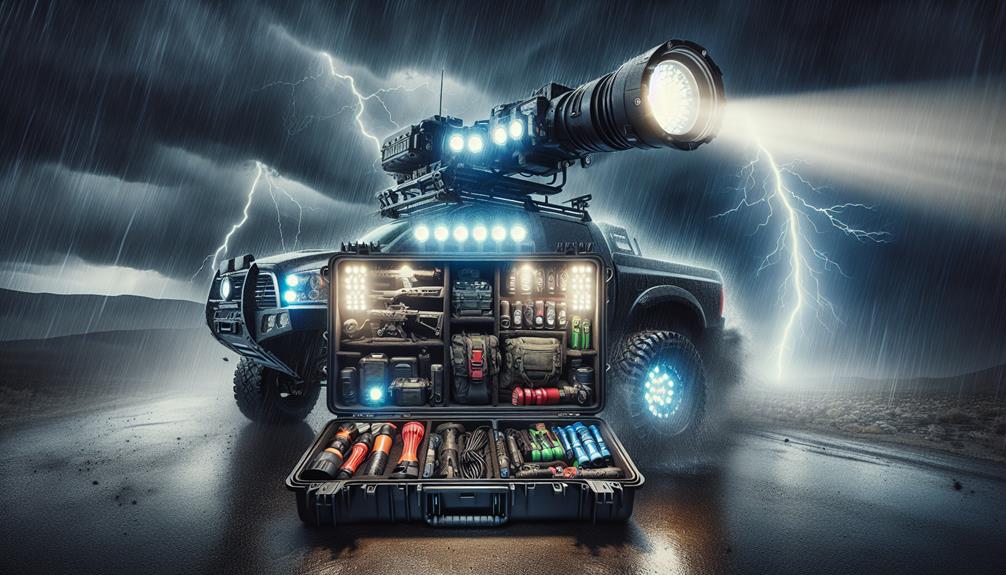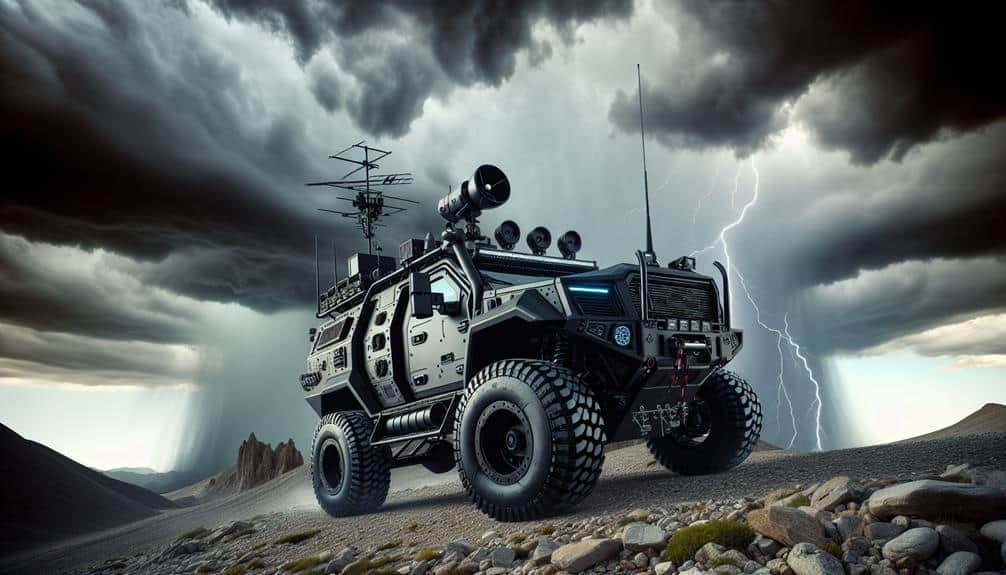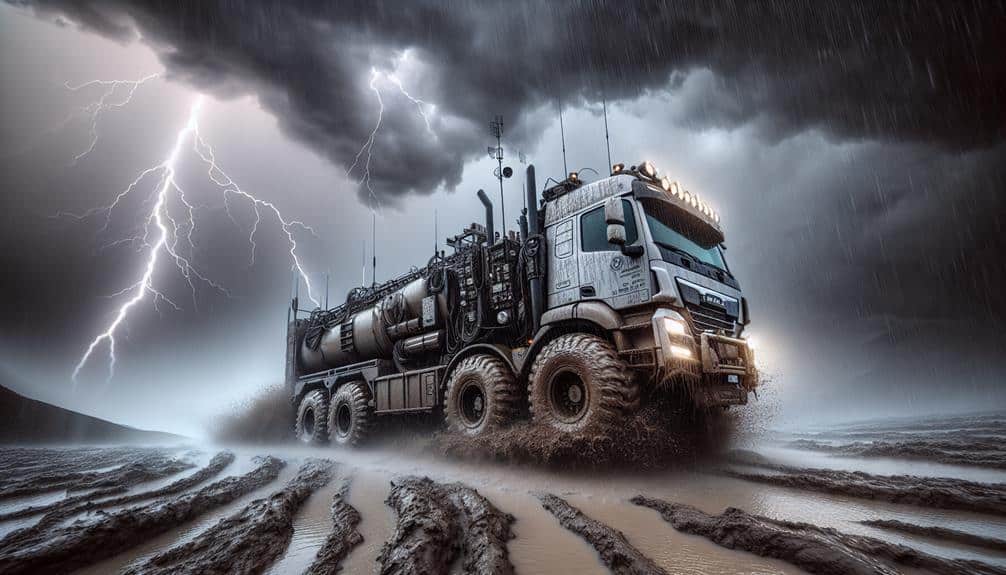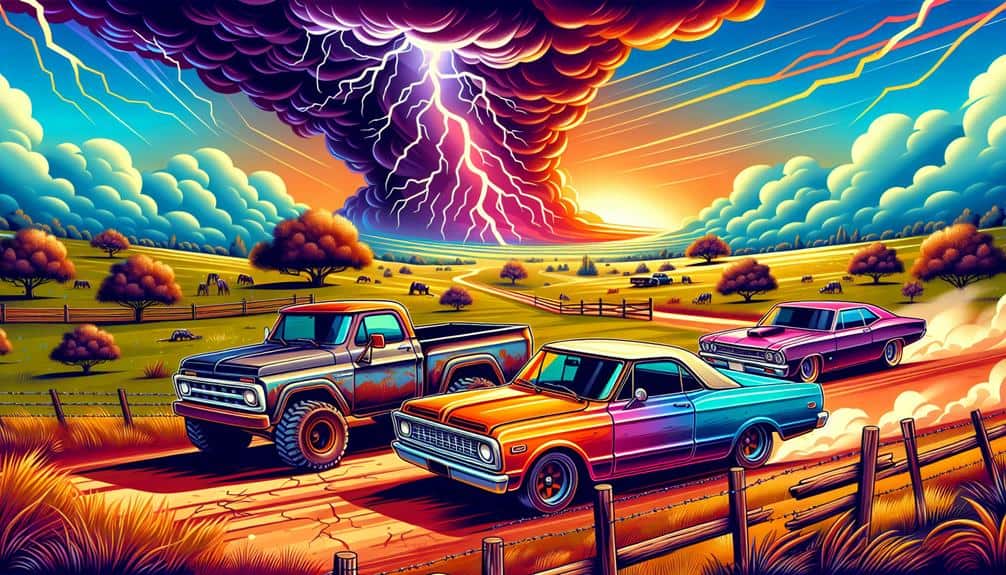We prioritize equipping our storm chasing trucks with essential emergency kits to navigate the inherent risks and enhance operational safety effectively. Seven must-haves include thorough first aid supplies to address injuries and satellite phones for robust communication. We also rely on high-quality weather monitoring tools, complete vehicle repair kits, and non-perishable food and water supplies for continuity. Emergency lighting, like LED bars and strobe lights, boosts visibility, while protective gear, including extra clothing, keeps us prepared for unexpected weather changes. These components notably reduce the risk during our storm chasing ventures and contribute to a safer and more efficient operation. Explore further to understand the specifics.
Key Points
- First aid kit: Crucial for treating injuries encountered during storm chasing.
- Roadside emergency kit: Includes jumper cables, reflective triangles, and other essential tools for vehicle issues.
- Weather radio: Essential for real-time monitoring of weather updates and warnings.
- Fire extinguisher: Necessary for tackling potential vehicle fires.
First Aid Supplies
We must always make certain our emergency kits include thorough first aid supplies to address potential injuries during storm chasing expeditions. When we're out in the field, the risk of encountering hazards like flying debris, strong winds, or sudden impacts increases exponentially. That's why our emergency response needs to be swift and effective. Stocking our trucks with a well-equipped first aid kit is an essential safety measure.
Data shows that immediate medical attention can reduce the severity of injuries by up to 60%. Our first aid supplies should include essentials like bandages, antiseptics, pain relievers, and sterile gloves. Additionally, we should carry items for more severe injuries, such as a tourniquet, splints, and burn treatments. A detailed first aid manual is also essential for guiding us through emergency procedures.
We've got to make sure our first aid supplies are regularly checked and restocked. Expired medications or depleted items can compromise our emergency response. By maintaining a meticulous inventory, we're not only adhering to safety measures but also empowering ourselves to take immediate action when it counts.
Being prepared with the right first aid supplies allows us to chase storms with the confidence and freedom we cherish.
Communication Devices
Effective communication devices are essential for coordinating storm chasing activities and guaranteeing team safety amidst unpredictable weather conditions. Our ability to stay connected can make the difference between a successful chase and a risky situation. Equipping our trucks with reliable communication tools is non-negotiable.
Satellite phones are vital for maintaining communication when we're beyond the reach of cell towers. They provide us with a direct line to emergency services, team members, and meteorological stations regardless of our location. Given the erratic nature of storm chasing, where we often find ourselves in remote areas, satellite phones offer an unparalleled advantage in relation to connectivity and safety.
Walkie talkies serve as our immediate, on-the-ground communication devices. These handheld radios allow for real-time coordination between team members within a certain range, ensuring we can relay critical information quickly. With frequencies that we can customize, walkie talkies help us avoid interference and maintain clear communication even amidst the chaos of a storm.
Incorporating both satellite phones and walkie talkies into our emergency kits ensures we've a robust communication network. This dual approach maximizes our operational efficiency and safety, allowing us to focus on the chase with confidence and freedom.
Weather Monitoring Tools
Accurate weather monitoring tools are essential for predicting storm patterns and ensuring our safety during storm chasing expeditions. When we're out in the field, real-time data analysis is critical. High-resolution radar systems allow us to observe storm cell development and movement, which is vital for making informed decisions. By integrating Doppler radar data, we can assess wind speeds and identify potential tornado formations with greater forecast accuracy.
We also rely on portable weather stations for localized data collection. These devices measure temperature, humidity, barometric pressure, and wind speed at our specific location, providing invaluable insights that enhance our predictive models. With this data, we can make better on-the-spot decisions about our route and positioning.
Satellite communication systems play a pivotal role as well. They enable us to access up-to-date weather models and forecasts from meteorological agencies. By analyzing this external data alongside our own, we improve our overall situational awareness and forecast accuracy.
Ultimately, we need these weather monitoring tools to navigate the unpredictability of severe storms. The freedom to chase safely depends on our ability to analyze data accurately and respond to evolving weather conditions in real-time.
Vehicle Repair Kit
Alongside our weather monitoring tools, maintaining a well-equipped vehicle repair kit is imperative for mitigating mechanical issues that could jeopardize our storm chasing missions. A thorough vehicle repair kit guarantees we remain mobile, even in the face of unexpected breakdowns.
First, let's talk about tire-related issues. A tire patch kit and a spare tire are non-negotiable. Flat tires are a common occurrence, especially when negotiating debris-strewn roads. A tire patch kit allows us to address minor punctures quickly, while a spare tire serves as a reliable backup for more severe damage.
Next, we need to address engine maintenance. Carrying an extra oil filter can be a lifesaver. In the high-stress environment of storm chasing, engines can take a beating. An oil filter ensures our engine runs smoothly, reducing the risk of breakdowns during critical moments.
Lastly, jumper cables are essential for battery-related issues. A drained battery can leave us stranded, but with jumper cables, we can quickly restart our vehicle and get back on the road.
Ensuring our vehicle repair kit is complete and ready reduces the risk of mechanical failure, providing us the freedom to focus on the storm.
Food and Water Storage

When storm chasing, it's necessary we store sufficient food and water supplies to ensure we stay nourished and hydrated during extended periods on the road. We need to take into account both food preservation and effective hydration solutions to maintain our energy and focus.
First, let's talk about food preservation. Non-perishable items like canned goods, dried fruits, nuts, and energy bars are our best options. These items have a long shelf life and don't require refrigeration. We should also include vacuum-sealed meals, which retain nutrients and flavor without the need for complex preparation. A portable cooler with ice packs can keep perishable items fresh for a limited time, but it's important to monitor temperatures.
Hydration solutions are equally important. Each of us should carry a minimum of one gallon of water per day. Collapsible water containers are efficient for storage and transport, while water purification tablets and portable filters ensure we can safely use local water sources if needed. Electrolyte tablets or powders are excellent additions to our kit, helping to replenish essential minerals lost through sweat and exertion.
Protective Gear
To stay safe while storm chasing, we must equip ourselves with appropriate protective gear that can withstand severe weather conditions. For starters, helmets are critical safety equipment. Data from the National Weather Service shows that falling debris poses a substantial risk during tornadoes and severe storms. Helmets designed to protect against high-impact forces can markedly reduce head injuries.
Next, let's consider protective clothing. Waterproof and wind-resistant jackets and pants are essential. According to a study by the American Meteorological Society, storm chasers exposed to high winds and heavy rain have a 50% higher risk of hypothermia if not properly attired. Additionally, steel-toed boots provide necessary foot protection from sharp objects and heavy debris.
Gloves with reinforced palms and fingers are another must-have. They offer enhanced grip and protect our hands from cuts and abrasions. Given that we often handle various equipment and navigate through rough terrain, this protective gear is indispensable.
Lastly, eye protection, such as safety goggles, shields our eyes from flying debris and dust, ensuring we maintain clear vision.
Equipped with the right safety equipment, we can confidently and safely pursue the thrilling freedom that storm chasing offers.
Emergency Lighting

When considering emergency lighting for our storm chasing trucks, we need to evaluate the types of lights available. These may include LED bars, strobe lights, and floodlights.
We should also analyze the best mounting locations to guarantee maximum visibility and safety during severe weather conditions. By focusing on these factors, we can enhance our operational effectiveness and minimize potential hazards.
Types of Emergency Lights
Emergency lights for storm chasing trucks come in several types, each designed to enhance visibility and safety under extreme weather conditions. These lights are critical for ensuring we remain visible to other vehicles and can safely navigate through severe storms.
Let's explore the different types of emergency lighting options available:
- LED Light Bars: These offer high-intensity illumination and are highly energy-efficient. LED light bars provide broad visibility enhancements, making them ideal for illuminating large areas during low-light conditions.
- Strobe Lights: Known for their intense, pulsating light, strobe lights grab immediate attention. They're particularly useful for alerting other drivers to our presence in adverse weather, helping to prevent accidents.
- Beacon Lights: These rotating or flashing lights are generally mounted on the roof and provide 360-degree visibility. Beacon lights are effective in signaling our position from all angles, ensuring maximum awareness from other road users.
- Flood Lights: Offering wide coverage and substantial brightness, flood lights are perfect for illuminating specific areas around the truck. They're useful for detailed inspections and tasks that require focused lighting.
Mounting and Visibility
Proper mounting and improved visibility of emergency lighting on storm chasing trucks greatly enhance our safety and operational efficiency during severe weather events. When considering mounting options, we must prioritize both the stability and accessibility of the lights.
Roof-mounted lights provide a high vantage point, maximizing their visibility range. However, these require sturdy brackets to withstand high winds and debris. Alternatively, grille or bumper-mounted lights offer lower mounting positions, which can be advantageous in low-visibility conditions like heavy rain or fog.
Visibility enhancement is crucial. Using LED lights with high lumens output guarantees that our trucks are seen from a considerable distance, reducing the risk of collisions. Flash patterns also play an important role. Studies show that alternating flash patterns can increase visibility by up to 30%. Thus, we should opt for light systems with programmable flash patterns.
Moreover, we should consider the color of the emergency lights. Amber is universally recognized for caution, while blue and red can indicate emergency response. A combination of these colors can provide the best visibility enhancement.
Frequently Asked Questions
How Do I Ensure My Emergency Kit Stays Organized During a Storm Chase?
To guarantee our emergency kit stays organized during a storm chase, we use clear labeling and storage solutions. We prioritize compact organization and accessibility by utilizing modular containers, making quick access possible even in challenging conditions.
What Are the Best Practices for Safely Driving in Storm Conditions?
When it comes to safe driving in storm conditions, preparation is key. Prioritize maintaining our emergency kit's organization to guarantee quick access. Let's monitor weather data closely and adjust our speed to maintain control.
Can I Use Renewable Energy Sources to Power My Emergency Equipment?
We can indeed use renewable energy sources to power our emergency equipment. Solar panels and wind turbines, combined with battery storage and backup generators, provide a sustainable solution, ensuring energy freedom and reliability even in storm conditions.
How Often Should I Replace Items in My Emergency Kit?
Did you know 60% of emergency kits contain expired items? Let's replace essential items every six months. This replacement frequency guarantees our gear remains reliable, giving us the freedom to face any storm confidently and safely.
What Are Some Common Mistakes to Avoid While Storm Chasing?
When storm chasing, we must prioritize safety precautions and avoid common errors like neglecting vehicle maintenance or underestimating weather conditions. Proper planning and regular equipment inspections guarantee both our safety and the freedom to pursue our passion.


